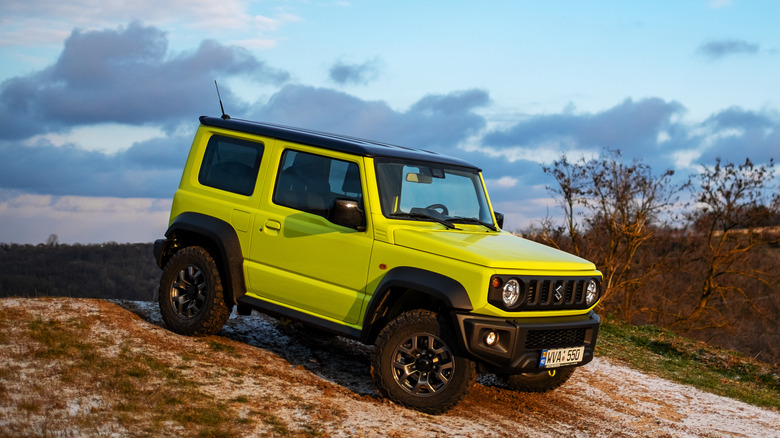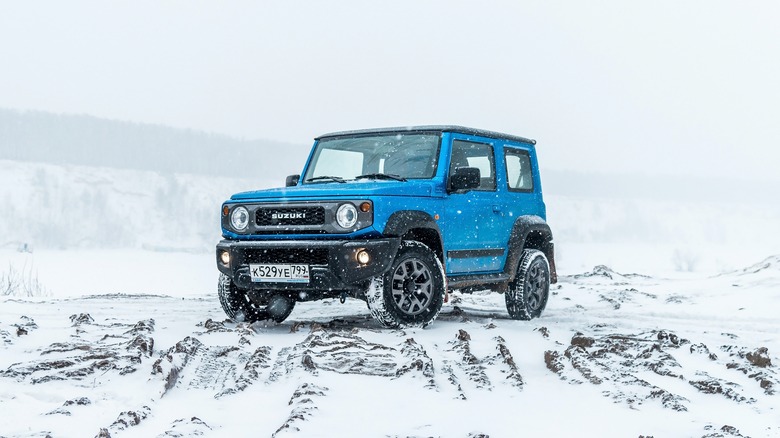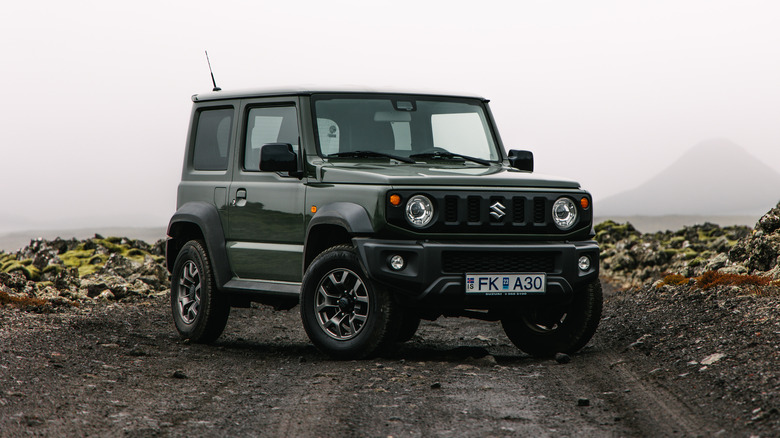Is Suzuki Building A New Samurai, And Is It Coming To The US?
Throughout the late 1980s, the Suzuki Samurai was one of the best-loved and best-selling sport utility vehicles in the North American market. However, Suzuki had been manufacturing the vehicle for more than a decade in Japan before it made its stateside debut in 1986. Born of Japan's once-booming Kei Car scene, the pint-sized Samurai became the first four-wheeled vehicle Suzuki — who has sold motorcycles in the U.S. since the mid-1960s — offered to American consumers.
The Samurai's debut was beyond successful, as Suzuki's modestly priced SUV became an instant hit among U.S. drivers, with the manufacturer reportedly moving more than 100,000 units in its first year-and-a-half. By 1988, the Suzuki sales force was moving 8,000 Samurais per month, and sales only seemed to be growing. Unfortunately, that same year, sales of the Samurai slowed considerably in the wake of a damning review from Consumer Reports that claimed the vehicle was easy to roll over under even normal driving conditions.
Though Suzuki brought legal action against Consumer Reports over the review, the vehicle's sales never fully recovered in America, and the Samurai disappeared from U.S. sales floors in the mid-90s. The Jimny (another name for the Samurai, more on that in a bit) has remained popular with the off-road set in the years since, and that feisty crew has been encouraged of late that Suzuki may be manufacturing a new Samurai. That report isn't entirely accurate, however, in part because Suzuki never stopped building the Samurai in the first place.
The Suzuki Samurai has been in production for decades
Yes, you read that correctly. Suzuki did not stop building their tiny SUV when they stopped selling it in the United States. They've merely been making and selling the vehicle under a different name to virtually every other market in the world. That name is the Jimny, and it might surprise you to learn that was the vehicle's given name when Suzuki began manufacturing the light jeep in the late 1960s. In fact, the SUV was only ever sold under the Samurai moniker in the U.S. markets, with the rest of the Suzuki-buying world hailing it as the Jimny.
As for the legal drama with Consumer Reports, the parties eventually settled out of court, and it seems the rest of the world was largely unfazed by the debacle that derailed the Samurai's booming U.S. sales numbers. With the Jimny in steady production since the late-1960s, Suzuki has continued to evolve the vehicle's style. They debuted the two-door, third-generation Jimny a couple of years after the Samurai disappeared from the U.S. market, and kept that model in production for two decades.
The fourth-generation Jimny arrived in 2018. It did so with a trove of upgrades and a dash of retro style in the body. Five years later, the mini SUV got one of its most significant upgrades to date, with Suzuki debuting a stretched-out version boasting a larger body and, most importantly, two more passenger doors that make it easier to get into and out of the Jimny's infamously tricky rear seats.
Suzuki's SUV is not available for purchase in the United States
While Suzuki's five-door refresh of the Jimny has only made the light jeep more intriguing to some U.S. interests, the vehicle is still not available to purchase in America. Unfortunately for U.S. fans, Suzuki appears to have no immediate plans to re-enter the U.S. automobile market, which the company essentially abandoned in 2013.
However, there may be good reason to speculate whether that might soon change, and Jimny's plus-sized re-design is the proof. After all, going big with their miniature SUV could be seen as a move to distance the Suzuki Jimny from the tricky history that doomed the two-door Samurai in the wake of the Consumer Reports review. Likewise, as sales of SUVs are as strong as ever in the U.S., the market might be tempting enough for Suzuki to test the waters with their 5-door Jimny. With the vehicle's original name still in play, the company could even further distance it from its past by marketing it under a different name instead of Samurai.
Still, a name change in the U.S. feels unlikely, as a Suzuki Samurai nostalgia play might be hard to pass up for the company's marketing machine. That is all pure speculation, of course, as Suzuki appears to be selling enough Jimnys without the aid of the U.S. market. For now, it seems American fans of the Suzuki Samurai are stuck to either lust after new models of the vehicle from afar or merely scouring the used car market for an old-school Samurai they can resto-mod on their own.


